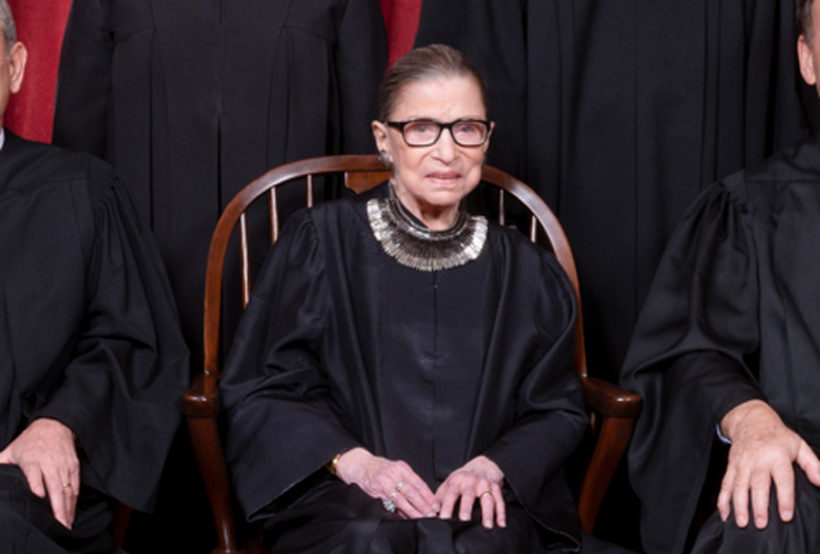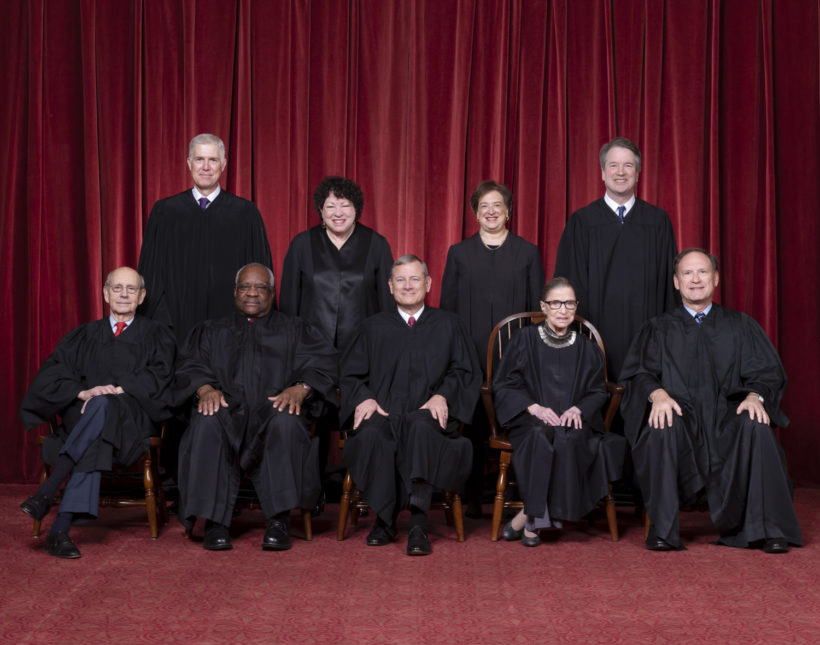
Ruth Bader Ginsburg, 2018
redo Jump to...
print Print...
Lying in repose is the tradition in which the body of a deceased person, often of high social stature, is made available for public viewing. Lying in repose differs from the more formal honor of lying in state, which is generally held at the principal government building of the deceased person’s country and often accompanied by a guard of honor.
(by Melissa Quinn, CBS News) — The body of Justice Ruth Bader Ginsburg will lie in repose at the Supreme Court on Wednesday and Thursday, the court announced. The late justice will also lie in state in Statuary Hall in the U.S. Capitol on Friday, House Speaker Nancy Pelosi said.
The Supreme Court said a casket carrying Ginsburg’s body will arrive in front of the Supreme Court on Wednesday morning, after which her family, friends and fellow justices will attend a private ceremony in the court’s Great Hall. Following the ceremony, Ginsburg will lie in repose at the top of the Supreme Court’s steps for a public outdoor viewing. [The public can pay respects from 11 a.m. to 10 p.m. on Wednesday, and again from 9 a.m. to 10 p.m. on Thursday.] The Supreme Court building has been closed to the public since March due to the coronavirus pandemic.
Ginsburg’s former law clerks will serve as honorary pallbearers, lining the front steps when her casket arrives at the court, and Supreme Court police officers will serve as pallbearers. Ginsburg’s casket will be placed on the Lincoln Catafalque, which held President Abraham Lincoln’s casket.
Additionally, the Supreme Court is paying tribute to Ginsburg by draping a black wool crepe on her chair and the bench in front of it. According to NPR, “It’s a tradition that dates back to 1873 after the death of Chief Justice Salmon P. Chase.”

The Roberts Court, November 30, 2018. Seated, from left to right: Justices Stephen G. Breyer and Clarence Thomas, Chief Justice John G. Roberts, Jr., and Justices Ruth Bader Ginsburg and Samuel A. Alito. Standing, from left to right: Justices Neil M. Gorsuch, Sonia Sotomayor, Elena Kagan, and Brett M. Kavanaugh. Photograph by Fred Schilling, Supreme Court Curator’s Office.
After lying in repose at the Supreme Court, Ginsburg’s body will lie in state in the Capitol on Friday, Pelosi announced. A formal ceremony for invited guests will also be held.
[Ginsburg will be the first woman and second Supreme Court justice to lie in state in the Capitol. The only other Supreme Court justice to be granted the honor was William Howard Taft in March 1930. Taft served as President of the United States (1909-1913) and then served as the tenth Chief Justice of the Supreme Court (1921-1930).The civil rights icon Rosa Parks laid in honor in the Capitol rotunda in 2005, but as a government official, Ginsburg will be the first woman to lie in state in the Capitol.
The last person to lie in state in the Capitol was the late Rep. John Lewis (D-Ga.), who died in July. Lewis laid in state in the Capitol rotunda, but officials also displayed his casket at the top of the Capitol’s east front steps to allow for an outdoor public viewing that accommodated social distancing guidelines for the coronavirus pandemic].
A private interment service will be held at Arlington National Cemetery next week, the Supreme Court said.
Ginsburg died Friday at 87 from complications of metastatic pancreatic cancer. She served on the Supreme Court for 27 years and was a pioneer for women’s equality across her legal career.
It’s unclear whether proceedings at the Supreme Court and the U.S. Capitol will impact when President Trump names a replacement for Ginsburg. The president said Monday that he does not intend to announce his Supreme Court nominee until after funeral services for the late justice as a show of respect and noted he will do so on Saturday.
From an article at CBS News with excerpts from The Hill by Christina Marcos, The Hill and Town and Country by Caroline Hallemann. Reprinted here for educational purposes only. May not be reproduced on other websites without permission.
Questions
1. What is the difference between the two:
-lie in repose
-lie in state
2. a) When/where will Justice Ginsburg lie in repose?
b) When/where will Justice Ginsburg lie in state?
3. Where will Justice Ginsburg be buried?
4. What is significant about the way Justice Ginsburg is being honored this week?
5. Why will a black cloth be draped on Justice Ginsburg’s chair and the bench in front of it at the Supreme Court?
6. Watch the ceremonies for Justice Ginsburg Wednesday to Saturday. It will most likely be shown on various TV and cable stations and streaming and social media platforms. What are your thoughts on how our country honors a Supreme Court Justice?
CHALLENGE: Without looking it up:
-Which president nominated Ruth Bader Ginsburg to become the second female Supreme Court Justice?
-Who was the first female Supreme Court Justice, and which president nominated her?
Background
Ruth Bader Ginsburg, Associate Justice, was the first Jewish justice since the 1969 resignation of Justice Abe Fortas. She was the second female and the first Jewish female justice of the Supreme Court. She eventually became the longest-serving Jewish justice.
From her Supreme Court bio:
- Ruth Bader Ginsburg was born in Brooklyn, New York, March 15, 1933. She married Martin D. Ginsburg in 1954, and has a daughter, Jane, and a son, James.
- Ginsburg received her B.A. from Cornell University, attended Harvard Law School, and received her LL.B. from Columbia Law School. She served as a law clerk to the Honorable Edmund L. Palmieri, Judge of the United States District Court for the Southern District of New York, from 1959–1961.
- From 1961–1963, she was a research associate and then associate director of the Columbia Law School Project on International Procedure.
- Ginsburg was a Professor of Law at Rutgers University School of Law from 1963–1972, and Columbia Law School from 1972–1980, and a fellow at the Center for Advanced Study in the Behavioral Sciences in Stanford, California from 1977–1978.
- In 1971, Ruth Bader Ginsburg co-founded the Women’s Rights Project of the American Civil Liberties Union, and served as the ACLU’s General Counsel from 1973–1980, and on the National Board of Directors from 1974–1980.
- She served on the Board and Executive Committee of the American Bar Foundation from 1979-1989, on the Board of Editors of the American Bar Association Journal from 1972-1978, and on the Council of the American Law Institute from 1978-1993.
- Ginsburg was appointed a Judge of the United States Court of Appeals for the District of Columbia Circuit in 1980.
- President Clinton nominated her as an Associate Justice of the Supreme Court, and she took her seat August 10, 1993.
- Justice Ginsburg died on September 18, 2020. (from supremecourt.gov)
Daily “Answers” emails are provided for Daily News Articles, Tuesday’s World Events and Friday’s News Quiz.


